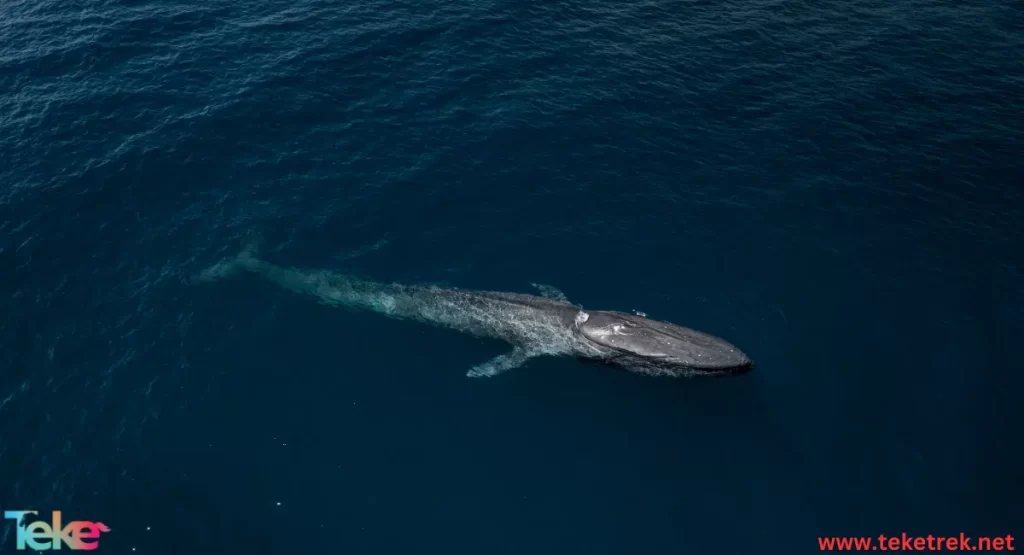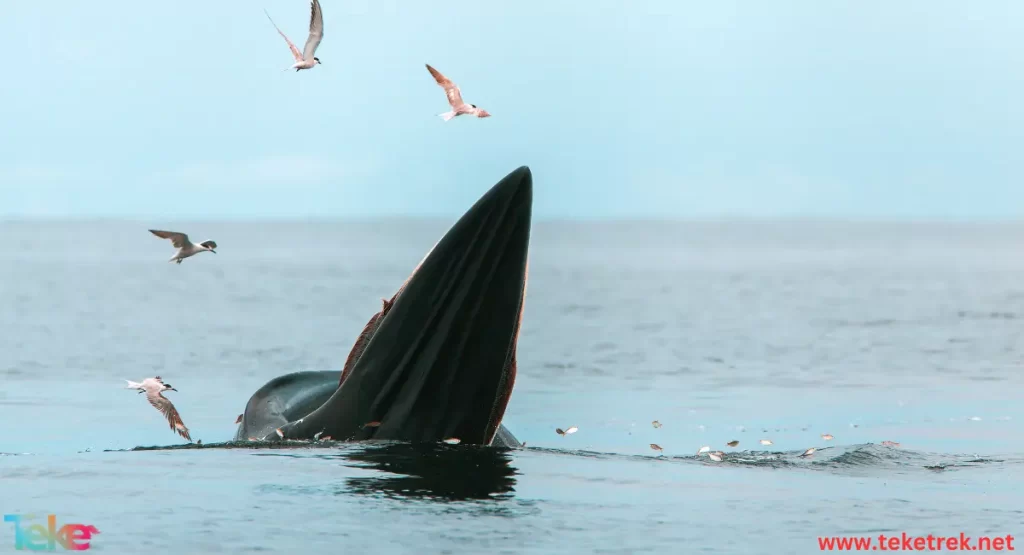The bowhead whale, the charming marine creature that we will start talking about when diving into the world of seas and oceans, tells a mysterious story with its bowed head and huge body that looks like a ship floating in worlds that are not easily understood.
The bowhead whale is one of the greatest wonders of nature, which has received great attention from scientists who love searching for everything that is distinctive and surprising in marine life. With its unique features, it constitutes an amazing fact that arouses curiosity.
In this article, we will learn together from teketrek about the bowhead whale, its habitat, features, food, and many other important details.

About the bowhead whale
The bowhead whale is a marine mammal that is widely distributed in the Arctic Ocean near floating ice masses, especially in Davis Strait, the Siberian Seas and the Greenland Sea. We also notice the presence of bowhead whales in the winter near Alaska, southwest of the Bering Sea, while in the spring they migrate north to hunt marine plankton and krill, specifically to the Chukchi and Beaufort seas. Knowing that its location varies according to the amount of ice that has melted or formed due to climate changes.
The bowhead whale belongs to the order Cetacea, phylum Chordata, subfamily right whales, class Mammalia.
It is also known as the Arctic Whale and the Greenland Right Whale.
The bowhead whale is considered a slow swimmer. We find it traveling alone or in small pods of up to six whales. Although it stays underwater for up to forty minutes in one dive, it is likely that it does not dive to great depths.
The bowhead whale is an extremely vocal animal, known to use underwater sounds as a way to communicate while feeding, traveling and making friends. In addition to making many long, repetitive songs, this is likely a mating display.
What are the characteristics of a bowhead whale?
First of all, it must be noted that this name was given to the bowhead whale as a result of the strong curvature of the lower jaw with which it is known, in addition to the narrowness of the upper jaw, as this is considered one of the most important features it has, and below we will mention its formal characteristics:
The length of the bowhead whale reaches 20 meters, although females are larger than males.
The bowhead whale weighs 80 tons.
The bowhead whale has a caudal fin that reaches about 7 meters in length.
The bowhead whale is dark black in color with a white spot under its mouth.
The length of the bone plates of the jaw of a bowhead whale exceeds 3 meters.
The bowhead whale has a huge bony skull, which helps it break through the ice to breathe.
The bowhead whale has a thick blubber layer with an average thickness of between 43-50 cm.
The bowhead whale has blowholes at the tip of its head, capable of pumping water up to a height of 20 feet.
What we mentioned in the previous points are some of the physical characteristics that the bowhead whale possesses, which reinforce what we mentioned at the beginning that it is a unique creature that is distinguished from other marine creatures by possessing prominent characteristics of its own.
What is the food of the bowhead whale?
The bowhead whale is a carnivorous marine animal that depends on eating a group of fish and other marine organisms for its food. It feeds by filtering food, by chasing its food by swimming towards the prey it wants to eat while opening its mouth in order to catch the food in the jaw bristles.
The bowhead whale is distinguished from other baleen whales in that it keeps its mouth constantly open when swimming forward, in order to filter the water and filter the prey that it captures and attaches to the bristles. This is instead of swallowing a large number of prey at a time, as is the case with other whales.
It should be noted that the bowhead whale can hunt very small prey, thanks to the thin hairs it possesses, which are supported by approximately 350 bony plates. These thin hairs thus act as a filter by allowing water to pass through while holding them together to prevent the prey from escaping. Here are some examples of the prey it eats:
Plankton
Copepods
Krill
Small crustaceans
Octopus
Houbara bustard
Catfish
Anchovies
So we can say that the bowhead whale’s diet is a complete and rich food that depends on diversity to ensure that it obtains the various nutrients it needs in order to grow and survive.
Reproduction stages of the bowhead whale
Researchers interested in knowing the secrets of the bowhead whale have noted that its mating season begins from March until August and often occurs in March.
When the male bowhead whale feels that the female is ready to mate, he displays a certain behavior that includes singing, jumping, and punching his tail to attract attention. Below we will mention some points related to this matter:
The bowhead whale begins to reproduce when it reaches between 10-15 years.
Reproduction occurs in deep, cold water.
The female bowhead whale gives birth to one baby every 3-4 years.
The pregnancy period lasts between 13-14 months.
The length of this newborn whale calf reaches 4.5 meters, and reaches 9 meters when it reaches one year of age, and its weight at birth is about 1000 kg.
The mother feeds the baby with milk for a year.
The bowhead whale calf can then swim independently within 30 minutes of birth.
The bowhead whale’s reproductive process is certainly a major part of its life cycle, which in turn contributes to replenishing the number of this whale in the oceans and ensuring its continuation for future generations.
Interesting facts about the bowhead whale
As we mentioned previously, the bowhead whale is an amazing and exciting marine creature. Here are some facts that distinguish it from other marine creatures:
The bowhead whale has a complex social life, as it forms social groups known as (families), in addition to exchanging care and support among group members.
The bowhead whale has a high level of intelligence, which makes it capable of solving its problems and interacting with its environment in an advanced manner.
The bowhead whale makes complex singing sounds called whale singing.
The bowhead whale is one of the loudest marine creatures, making sounds that reach kilometers in the ocean.
The bowhead whale is a marine mammal and, as a result, is a warm-blooded animal that breathes air, gives birth, and produces milk.
The bowhead whale has a lifespan of about 100 years, although a few bowhead whales that were in good condition have lived to be nearly 200 years old.
Although it has a bowed head, it can jump well in the water.
Its speed reaches 6.2 mph.
We conclude from this that the bowhead whale constitutes a unique world in itself that deserves to be given a lot of attention.

FAQs about the bowhead whale
- How old is a bowhead whale?
The bowhead whale is over 200 years old.
- How many bowhead whales are left in the world?
There are only 10,000 bowhead whales left in the world.
- Why are bowhead whales being killed?
They are hunted by humans for food or fuel.
In the end, we have reached the conclusion of this article in which we talked about the bowhead whale, which shines as a symbol of strength and beauty, and maintains the balance of the marine environment with its system. Therefore, we must strive together to maintain its continuity, as it deserves all care and attention





